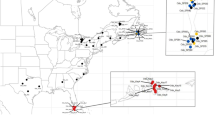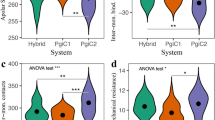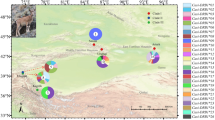Abstract
To investigate genetic differentiation among populations of the wood lemming Myopus schisticolor (Muridae, Rodentia) isozyme variation in 10 populations from three regions, Fennoscandia, Western and Eastern Siberia, was examined. From 20 loci examined, the two most polymorphic ones, Idh-1 and Pgi-1, were used in the complete survey. The results of hierarchical F-statistics analysis showed significant differentiation among all populations; single locus FPT values agreed well (Idh-1, FPT = 0.20; Pgi-1, FPT = 0.20). However, allele frequencies at each locus demonstrated different patterns of subdivision among populations within regions and between regions. Thus, significant values of F-statistics within (FPR = 0.10) and between (FRT = 0.10) regions were found at Idh-1. Pgi-1 showed no significant differentiation among populations within regions (FPR = 0.01). The subdivision among populations at Pgi-1 was based on differentiation between regions (FRT = 0.19). The lack of differentiation among populations within a geographical region at the Pgi-1 locus is surprising for any rodent species, and the discrepancy between single-locus patterns of subdivision seems likely to result from selection at the Pgi-1 locus.
Similar content being viewed by others
Article PDF
References
Bondrup-Nielsen, S, Ims, R A, Fredriksson, R, and Fredga, K. 1993. Demography of the wood lemming, Myopus schisticolor. In: Stenseth, N. C. and Ims, R. A. (eds) The Biology of Lemmings, pp. 493–507. Academic Press, London.
Chesser, R G. 1983. Genetic variability within and among populations of the black-tailed prairie dog. Evolution, 37, 320–331.
Fedorov, V B. 1990. Allozyme polymorphism in a natural population of wood lemmings (Myopus schisticolor Lill.). Genetika, 26, 1324–1328. (In Russian).
Fedorov, V B. 1993. Genetic variation in the wood lemming Myopus schisticolor. Ecologya, 1, 70–82. (In Russian).
Felsenstein, J. 1993. PHYLIP (Phylogeny Inference Package) version 3.5p. Distributed by the author. Department of Genetics, University of Washington, Seattle.
Fredga, K, Gropp, A, Winking, H, and Frank, F. 1976. Fertile XX- and XY-type females in the wood lemming, Myopus schisticolor. Nature, 261, 225–227.
Fredga, K, Gropp, A, Winking, H, and Frank, E. 1977. A hypothesis explaining the exceptional sex ratio in the wood lemming (Myopus schisticolor). Hereditas, 85, 101–104.
Fredga, K, Fredriksson, R, Bondrup-Nielsen, S, and Ims, R A. 1993. Sex ratio, chromosomes and isozymes in natural populations of the wood lemming, Myopus schbticolor. In: Stenseth, N. C. and Ims, R. A. (eds) The Biology of Lemmings, pp. 465–491. Academic Press, London.
Gileva, E A, and Fedorov, V B. 1991. Sex ratio, XY females and absence of inbreeding in a population of the Wood Lemming, Myopus schisticolor Lilljeborg. 1844. Heredity, 66, 351–356.
Gorbunov, S M, and Kulik, I L. 1974. Cadastre-information map of the wood lemming, Myopus schisticolor, range. Zoologiceskij Zurnal, 53, 144–146. (In Russian).
Hartl, D L, and Clark, A G. 1989. Principles of Population Genetics, 2nd edn. Sinauer, Sunderland, MA.
Leigh Brown, A J. 1977. Genetic changes in a population of field mice (Apodemus sylvaticus) during one winter. J Zoo, 182, 281–289.
Manly, B F J. 1991. Randomization and Monte Carlo Methods in Biology. Chapman & Hall, London.
McElroy, D, Moran, P, Bermingham, E, and Kornfied, I. 1992. REAP: an integrated environment for the manipulation and phylogenetic analysis of restriction data. J Hered, 83, 157–158.
Navajas-Navarro, M, and Britton-Davidian, J. 1989. Genetic structure of insular Mediterranean populations of the house mouse. Biol J Linn Soc, 36, 377–399.
Pamilo, P, Pekkarien, A, and Varvio, S L. 1987. Clustering of bumble bee subgenera based on interspecific genetic relationships (Hymenoptera, Apidae: Bombus and Psithyrus). Ann Zoo Fenn, 24, 19–27.
Patton, J L, and Smith, F S. 1990. The evolutionary dynamics of the pocket gopher Thomomys bottae, with emphasis on California populations. Univ Calif Publ in Zool, 123, 1–149.
Riddoch, B J. 1993. The adaptive significance of electrophoretic mobility in phosphoglucose isomerase (PGI). Biol J Linn Soc, 50, 1–17.
Rogers, J S. 1972. Measures of genetic similarity and genetic distance. Studies in Genet VII Univ Texas Publ, 7213, 145–153.
Roff, D A, and Bentzen, P. 1989. The statistical analysis of mitochondrial DNA polymorphism: X2 and the problem of small samples. Mol Biol Evol, 6, 539–545.
Rohlf, F G. 1988. NTSYS-pc: Numerical Taxonomy and Multivariate Analysis System, Exter Publishing Ltd, New York.
Slatkin, M. 1987. Gene flow and the geographic structure of natural populations. Science, 236, 787–792.
Swofford, D L, and Selander, R B. 1981. A computer program for the analysis of allelic variation in genetics. J Hered, 72, 281–283.
Weir, B S. 1990. Intraspecific differentiation. In: Hillis, D. M. and Moritz, C. (eds) Molecular Systematics, pp. 373–410. Sinauer, Sunderland, MA.
Wright, S. 1978. Evolution and Genetics of Populations, vol 4 Variability Within and Among Natural Populations. University of Chicago Press, Chicago.
Author information
Authors and Affiliations
Rights and permissions
About this article
Cite this article
Fedorov, V., Fredriksson, R. & Fredga, K. Genetic differentiation among populations of Myopus schisticolor (the wood lemming) — isozyme variation. Heredity 74, 267–273 (1995). https://doi.org/10.1038/hdy.1995.40
Received:
Issue date:
DOI: https://doi.org/10.1038/hdy.1995.40



